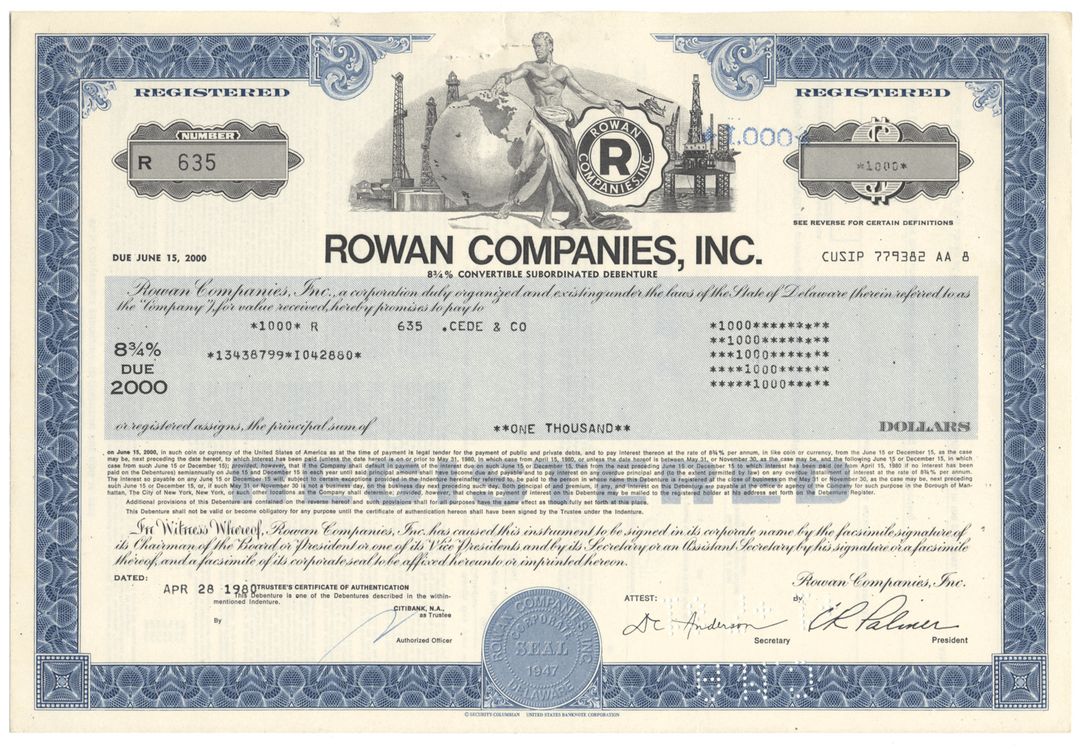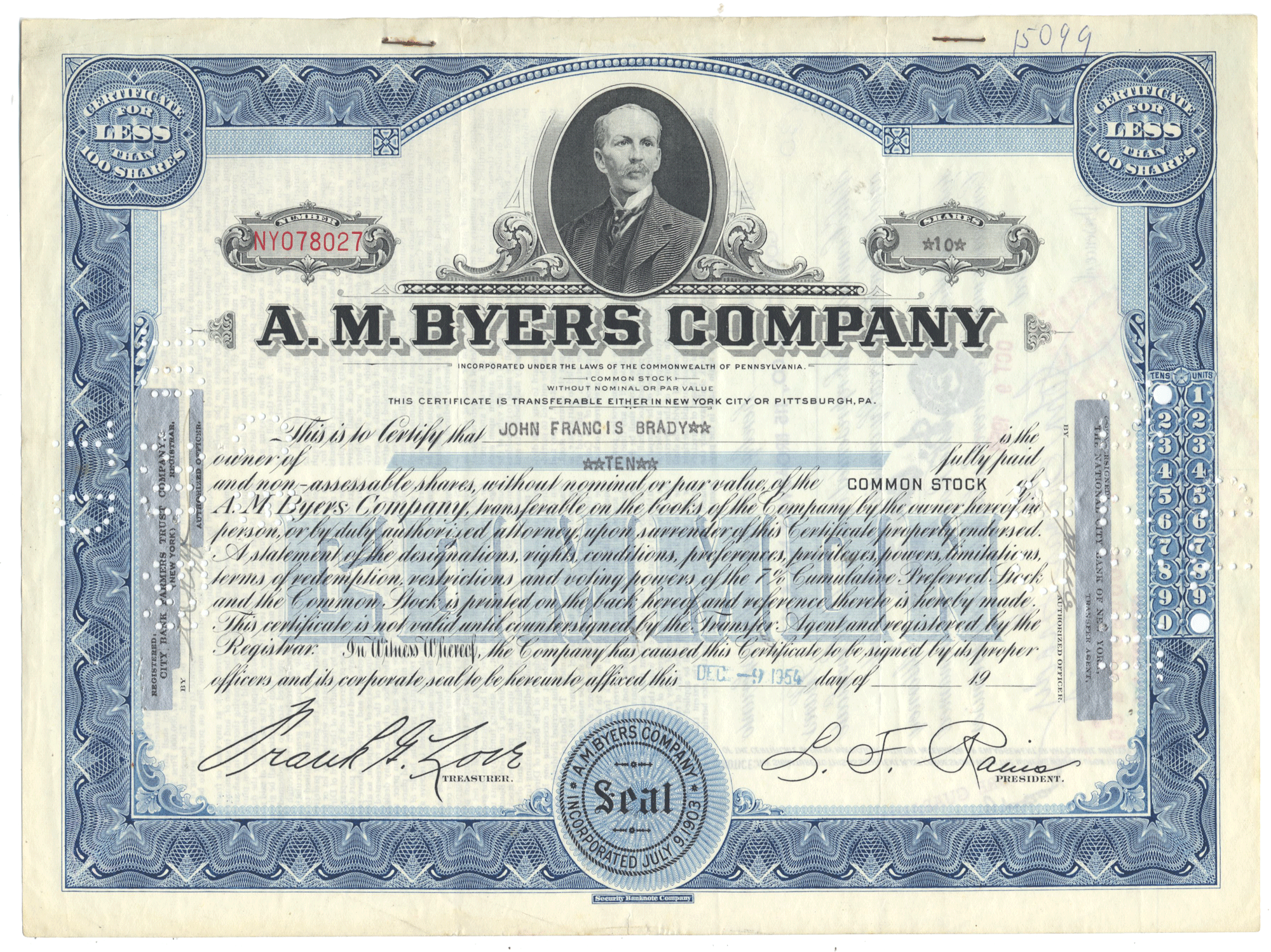
Rowan Companies, Inc.
- Guaranteed authentic document
- Orders over $75 ship FREE to U. S. addresses
Product Details
Rowan Companies, Inc.
Certificate Type
Convertible Subordinated Debenture Bond
Date Issued
1980's
Canceled
Yes
Printer
Security-Columbian/United States Bank Note Company
Signatures
Machine printed
Approximate Size
12" (w) by 8" (h)
Images
Representative of the piece you will receive
Guaranteed Authentic
Yes
Additional Details
NA
Historical Context
When brothers Charlie and Arch Rowan had the opportunity to purchase a drilling rig in 1923, they decided to seize the day. Charlie, who had experience in the oil fields with Humble Oil, convinced Arch to join him in the fledgling drilling operation in the now famous oil fields of Corsicana, Texas.
Incorporating in 1924 as Rowan Drilling, the company added to its inventory an additional oil rig, purchased for $5,500. With total capital of $30,000, the brothers set the new rig near the town of Wortham. They hit a gusher in November 1924 that reached 200 feet in the air. The event launched Rowan’s business and created an oil boom in the city of Wortham that continued until 1927.
In 1927, the Rowan brothers established a second company, Rowan Oil Company. The newly formed company was to sell the oil produced by Rowan Drilling. Headquartered in Fort Worth, the company did not begin making money until 1928.
Outside of east Texas, the Great Depression had hold on the rest of the country, but in the oil fields, jobs and oil continued to gush plentifully. In 1933, Rowan Oil Company dissolved. Its older counterpart, Rowan Drilling, was also dissolved but then reborn as a Delaware corporation. Four stockholders - Charlie Rowan, Arch Rowan, A.A. Klein, and Bess Brants - divided the company, with the Rowan brothers retaining the majority of the shares.
Drilling with steam power was state-of-the-art for the 1920s, but by 1935 Rowan was moving ahead of the industry by purchasing its first diesel electric rig. In the late 1930s, the company extended its reach beyond Texas and into the marshland of Louisiana.
Because of an excess flood of oil in the market, the Texas Railroad Commission began regulating the production for oil wells. In response to this regulation, Rowan sued the state agency in a case that eventually went all the way to the U.S. Supreme Court. However, Rowan lost the case (6-3) as the Supreme Court refused to overrule the judgment of a state agency.
The 1940s brought a new landscape to the world and the oil industry. As the United States entered World War II in 1941, oil production was a key factor in the war effort. Rowan was ready to support the war effort with improved drilling technology. Arch Rowan was a founding member of the Petroleum Industry War Council, an organization that later became the National Petroleum Council.
After the war was over in 1945, Rowan, as well as other oil drilling businesses, experienced difficulties. In 1948, imported oil began to have an impact and exceeded domestic oil for the first time. However, demand increased with a growth in automobile and aircraft use.
In 1948 Rowan Drilling Company split into two companies when Rowan Oil was resurrected. This change was in response to Texas liability law and was designed to protect oil holdings by separating the drilling and leasing operations. Internally, changes were happening as well. To facilitate company communication, Rowan launched The Rowan Grapevine, a company magazine for Rowan employees.
By the end of 1948, Rowan had 78 wells - 55 in Texas, 12 in New Mexico, and 11 in Louisiana. Accessing rigs in the swamps of Louisiana was challenging, so Rowan purchased a twin-engine Beechcraft airplane in 1948 to fly to those remote locations.
With 24 rigs in operation in three states, Rowan began the 1950s aggressively. In 1951, Rowan began offering benefits to its employees as well as establishing a joint headquarters in Fort Worth, Texas, for the two companies - Rowan Oil and Rowan Drilling.
Though marsh drilling in Louisiana had been successful, drilling in deep water was new to Rowan, and the company first attempted it in 1954 in the Gulf of Mexico. Despite being plagued by bad weather, Rowan persevered and added a second rig. Helicopters were used to transport crew to the rigs.
In 1955, after 32 years of leadership, Arch and Charlie Rowan retired. Hamilton Rogers became president of Rowan Oil Company, and Gilbert Rowe, who had joined Rowan Drilling in 1944, assumed leadership of that company. That same year, Rowan Drilling built the Rowan building in downtown Fort Worth to serve as its headquarters.
Ten years after being split into two companies, Rowan decided that, though initially beneficial due to Texas liability law, operating two companies was not advantageous to the overall organization. The assets of Rowan Oil Company were sold to Texas Pacific Coal & Oil Company in a $9.6 million deal. The remaining company, Rowan Drilling, extended drilling operations into Mississippi in 1958.
In 1961, company founder Charlie Rowan died. Tragedy followed in 1962 when Arch Rowan, Jr., died at the age of 32 as the result of burns received during an accidental fire at his home. Arch, Jr., was a member of the board of directors of Rowan Drilling.
With Gilbert Rowe at the helm, significant changes happened in the 1960s. In 1963, the company said goodbye to Fort Worth, its headquarters since 1927, and relocated to Houston, Texas. Rowan extended its drilling operations, continuing to add rigs, including one in Alaska in 1966.
The biggest change for the company occurred on September 6, 1967, when Rowan launched its initial public offering (IPO) of 323,000 shares. The decision to become a public company resulted from the need for more operating capital to fund offshore work and technological advances. Two thirds of the common stock following the IPO was still held by Rowan executives and employees.
As of September 30, 1967, Rowan had assets of $8.7 million. Offshore drilling accounted for 42 percent of contract-drilling revenues and 65 percent of net income from contract operations. The move into drilling further north in Alaska brought increased challenges for Rowan. Not only was the weather frigid and hostile, transportation was a problem for the company. This challenge led to the company’s decision in 1967 to purchase ERA Helicopters, Alaska’s largest helicopter business. With the companies increased capabilities, drilling contracts increased as well.
A new mobile drilling platform was designed and built to further Rowan’s oil drilling efforts. Its first contract operation was located off the eastern coast of Nicaragua in 1970 for Shell. A second mobile drilling platform was built and began work in the Gulf of Mexico. The company obtained contracts, with the help of this new equipment, in Nicaragua, Colombia, Honduras, and Venezuela. In 1972, a year after the business had renamed itself Rowan Companies, CEO Gilbert Rowe retired, with Bob Palmer named as his successor.
In 1973, the Yom Kippur War and ensuing embargo of U.S. oil supplies by the Organization of Petroleum Exporting Countries (OPEC) demonstrated U.S. oil dependence. The embargo caused a perceived shortage of gasoline, and OPEC raised the price of their oil. Also in 1973, Rowan purchased a second airline in Alaska—Merric, Inc. Together with Rowan’s subsidiary Era, the company now had 36 helicopters and 12 fixed wing aircraft. The airlines were immediately successful, jumping in revenue by 130 percent to $12.8 million by 1974. In 1978, Era built an aviation center at Anchorage International Airport to house the company’s fleet.
Related Collections
Additional Information
Certificates carry no value on any of today's financial indexes and no transfer of ownership is implied. All items offered are collectible in nature only. So, you can frame them, but you can't cash them in!
All of our pieces are original - we do not sell reproductions. If you ever find out that one of our pieces is not authentic, you may return it for a full refund of the purchase price and any associated shipping charges.





